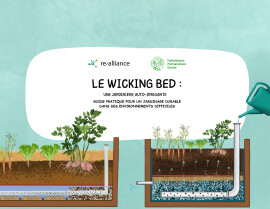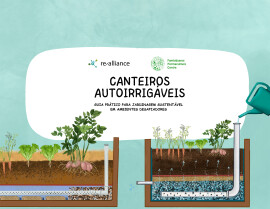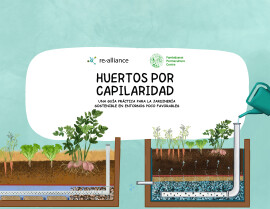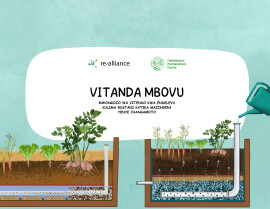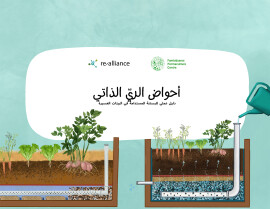
Meeting the Challenges of Animal Traction
A resource book of the Animal Traction Network for Eastern and Southern Africa (ATNESA)
This new resource book provides a wealth of ideas and experiences concerning animal traction in many countries. This publication has been developed from the ATNESA workshop held in Kenya on 'meeting the challenges of animal traction' and draws together key papers and contributions from professionals in 27 different countries. The papers address a number of important challenges to animal traction that relate to participation, environment, gender, extension, transport, equipment and animal husbandry. In addition, several papers describe national level challenges and project attempts to address these. It will be of great value to all those concerned with the development of animal power, tropical agricultural development and rural transport, especially those involved in participative research, training, extension, development, planning, gender issues and project implementation.
Published: 1999
Pages: 328
eBook: 9781780445458
Paperback: 9781853394836
| Preface and acknowledgements ..................................................................................................................6.. .... | |||
|---|---|---|---|
| Abbreviations and units .................................................................... . . ;. ...........................................................8.. . | |||
| Identifying the challenges: participatory research and socio-economic studies | |||
| A farming systems approach to improving draft animal power in sub-Saharan Africa ...............................1 0 | |||
| Forbes Muvirimi and Jim Ellis-Jones | |||
| Participatory technology development for ahimal traction: experiences from a semi-arid area of Kenya ......2 0 | |||
| David Mellis, Harriet Matsaert and Boniface Mwaniki | |||
| Socio-economic aspects of animal power: a diagnostic study in Zimbabwe ..............................................2..8 | |||
| R Tsimba, S Chawatama, L Ndow, J Mutimba, P Ndlovu, K Dzama, J Topps, D Hikwa and MMudhara | |||
| Animal traction and market conditions: a ckse study from south-western Tanzania and northern Zambia .....3 3 | |||
| Torben Birch-Thomsen | |||
| Draft animal power potential and utilisation in the Tonota District of Botswana ............: . ......................... 40 | |||
| J A Karim-Sesay | |||
| Users in control: farmer participation in technology research and development .........................................4. 5 | |||
| Simon Croxton | |||
| Challenging environmental issues | |||
| Animal traction in Africa: analysing its environmental impact ..................................................................5..2 | |||
| Roger Blench | |||
| Environmental influences on the adoption of animal traction ................................................................., .....6 0 | |||
| Michel Havard and Gtrard Le Thiec | |||
| Environmental impact of animal traction in Rukwa Region, Tanzania ........................................................6 8 | |||
| A M Kilemwa | |||
| Animal traction and sustainable soil productivity in Kenya ......................................................................... 72 | |||
| Isaiah I C Wakindiki | |||
| Gender challenges | |||
| Gender and animal traction: a challenging perspective ................................................................................. 76 | |||
| Juliana Rwelamira and Lotta Sylwander | |||
| Animal traction development and gender: experiences from Western Province, Zambia ............................ 82 | |||
| G M Bwalya and M Akombelwa | |||
| Gender and animal traction technology in eastern and southern Africa ....................................................... 86 | |||
| Florence Lawan Tangka | |||
| A note on gender issues in draft animal technology: experiences from Nyanza, Kenya .......: . ....................9 1 | |||
| William Onyango Ochido | |||
| Farmer knowledge, extension and training | |||
| Informal farmers' knowledge in animal traction: case studies from the southern highlands of Tanzania .......9 4 | |||
| E Kwilligwa, J Rock, M Massunga and M Siva | |||
| Towards privatisation in draft animal power extensio; ih Zambia ..'.. .................... :..... ............. :. ................ 98 | |||
| Martin van Leetiiven | |||
| Animal draft power training in Zimpbwe: experiences and future challenges ......: .. ..............: . ........ :. ...... 103. | |||
| B Mudamburi, B Chikwanda and J Francis | |||
| Extension methods for improving the welfare of traction animals .......................... .................................. 106 | |||
| Cheryl ME McCrindle and 2iakatsoE Moorosi | |||
| Animal-drawn equipment and harnessing | |||
| Conservation tillage for soil and water conservation using draft animal power in Zambia ....................... 112 | |||
| Kenneth Chelemu and Peter Nindi | |||
| The supply of animal-drawn implements in Tanzania ................................................................................ 118 | |||
| S Mkomwa and R M Shetto | |||
| Introducing animal-drawn cultivators in north Namibia: preliminary results and reasons for hope .......... 125 | |||
| Iylwa Veikko and Carole Pitois | |||
| Dynamic steering response of animal drawn plows .................................................................................... 130 | |||
| J.M Mutua and PA Cowell | |||
| Developing suitable yokes for draft oxen in sub-Saharan Africa ............................................................... 134 | |||
| Gerard Le Thiec and Michel Havard | |||
| Design and nianufacture of a withers yoke for zebu oxen and cows .......................................................... 140 | |||
| Wells F Kumwenda | |||
| Harnessing techniques and work performance of draft horses in Ethiopia ............................................... 143 | |||
| Mengistu Geza | |||
| Animal-based transport | |||
| Meeting the challenge of animal-based transport ........................................................................................ 150 | |||
| Ron Dennis | |||
| The development of low-cost animal-drawn carts ....................................................................................... 170 | |||
| C E Oram | |||
| Ox carts in Kaoma, Zambia ......................................................................................................................... 176 | |||
| Martin van Leeuwen and Nawa Siyambango | |||
| The 'Golovan' one-ox cart .......................................................................................................................1.8..4. | |||
| .Bruce Joubert | |||
| Animal issues: donkey use, cow traction and feeding | |||
| The challenges in using donkeys for work in Africa ......................................... ......................................... 190 | |||
| R A Pearson, E Nengomasha and R C Krecek | |||
| The potential of cow traction in the East African highlands ....................................................... ............... 199 | |||
| E Zerbini, Alemu Gebre Wold and B I Shapiro | |||
| Cow traction in Chokwe, Mozambique .............. ........................................................................................ 212 | |||
| 0 Fafine and A Mutsando | |||
| Comparative draft performance of oxen and heifers in northern Sierra Leone .......................................... 216 | |||
| G 0 Cole and J Steinbach | |||
| Dry season crop residue feeding for improved draft power in Zambia ...................................................... 220 | |||
| J H Meinderts, M Chibango and N Mwenda | |||
| Social and economic challenges in West Africa | |||
| Ox traction in a long-term perspective: policy implications of a socio-economic study in Ghana ........... 226 | |||
| J H Hesse and A Runge-Metzger | |||
| The potential for animal traction in south-westem Nigeria ..................................................... :. .................. 235 | |||
| Adebiyi Gregory Daramola | |||
| Evolution of farming systems and the adoption and profitability of animal traction ................................. 239 | |||
| Kizito Langha | |||
| The effects of the on-going war on animal traction in Sierra Leone .......................................................... 247 | |||
| Abu B Bangura | |||
| National challenges and perspectives | |||
| The challenges of animal traction in Tanzania .......................................................................................... 252 | |||
| H Sosovele | |||
| Animal traction in Mozambique: results from a survey of small-scale farmers ........................................2.5 8 | |||
| Alfredo de Toro and Alfredo B Nhanturnbo | |||
| The challenges of reintroducing animal traction in post-war Mozambique ..................................:.. . ..........2 64 | |||
| Alix von Keyserlingk | |||
| Animal draft power in South Africa: past, present and future ..................................................................2..6 9 | |||
| Richard Fowler | |||
| Animal draft power challenges in Zimbabwe .............................................................................................2. 74 | |||
| J Francis, B Mudamburi and B Chikwanda | |||
| Surveying animal traction use in Zambia ..................................................................................................2..7 8 | |||
| Henk J Dibbits | |||
| Possible initiatives for increased utilisation of animal traction in Malawi .................................................2 90 | |||
| M L Mwinjilo | |||
| Workhorses in Norway ............;.. ........... . ..............................................................................................2..9. 3 | |||
| Martin Aeschlirnann | |||
| Improving animal traction technology in Cuba ...........................................................................1.. .. ...........2 96 | |||
| Arcadio Rios | |||
| Addressing the challenges: project experiences | |||
| Animal traction development in Iringa Region, Tanzania: project approaches and future requirements ...... 300 | |||
| R Mwanakulya | |||
| The development of animal traction in Tanzania in recent years ................................................................3 04 | |||
| R N Mtunze and M G Lyirno | |||
| Reviving cotton production in eastern Uganda: the animal traction perspective .......................................3. 06 | |||
| Alex Nylrgo and John Olupot | |||
| Hiring and lending of oxen for plowing in Kaoma, Zambia ...................................................................3..0..8 | |||
| Kennedy Kakwaba and Martin van Leeuwen | |||
| Challenges of animal draft technologies in North Western Province, Zambia ....................... ;. ..................3 13 | |||
| Ivor Mukuka | |||
| Challenges and constraints of animal traction in þapulaP rovince, Zambia ............................................. 3 19 | |||
| Alexander Mutali t | |||
| Index .......................................................................................................................................................3..2 2 |
Paul Starkey Paul Starkey, is a specialist in animal traction and rural transport. For many years he has acted in a voluntary capacity as Technical Adviser to animal traction networks in Africa. He has published widely and has been called upon to advise the International Forum for Rural Transport and Development and also development networks in Africa, Asia and Latin America on networking issues.
Energy transition from molecules to atoms and photons
Khan, N.
Kalair, E.
Abas, N.
Kalair, A.R.
Kalair, A.
Engineering Science and Technology, an International Journal, Vol. 22 (2019), Iss. 1 P.185
https://doi.org/10.1016/j.jestch.2018.05.002 [Citations: 29]Coprological detection of equine nematodes among slaughtered donkeys (Equus asinus) in Kaltungo, Nigeria
Egbe-Nwiyi, Tobias Nnia
Paul, Bura Thlama
Cornelius, Ajuji Chungsyn
Veterinary World, Vol. 12 (2019), Iss. 12 P.1911
https://doi.org/10.14202/vetworld.2019.1911-1915 [Citations: 5]Increasing the Comfort of the Harianavi Bullocks by Reduction of Contact Pressure on Neck by Designing a Body Contoured Yoke
Tyagi, R. K.
Singh, Achhaibar
Journal of Applied Animal Welfare Science, Vol. 23 (2020), Iss. 4 P.424
https://doi.org/10.1080/10888705.2019.1678037 [Citations: 0]Vector Ecology of Equine Piroplasmosis
Scoles, Glen A.
Ueti, Massaro W.
Annual Review of Entomology, Vol. 60 (2015), Iss. 1 P.561
https://doi.org/10.1146/annurev-ento-010814-021110 [Citations: 155]The environmental ecology of oxen used for draught power
Wilson, R.Trevor
Agriculture, Ecosystems & Environment, Vol. 97 (2003), Iss. 1-3 P.21
https://doi.org/10.1016/S0167-8809(03)00118-X [Citations: 31]RICE MECHANIZATION IN ETHIOPIA: TRENDS, AND PROSPECTS
DESSYE, Tikuneh
LAIKE, Woldesenbet
(2023) P.335
https://doi.org/10.35633/inmateh-69-31 [Citations: 0]Mapping the economic benefits to livestock keepers from intervening against bovine trypanosomosis in Eastern Africa
Shaw, A.P.M.
Cecchi, G.
Wint, G.R.W.
Mattioli, R.C.
Robinson, T.P.
Preventive Veterinary Medicine, Vol. 113 (2014), Iss. 2 P.197
https://doi.org/10.1016/j.prevetmed.2013.10.024 [Citations: 138]A quantitative risk assessment of bovine theileriosis entering Luapula Province from Central Province in Zambia via live cattle imports from traditional and commercial production sectors
Makungu, C.
Mwacalimba, K.K.
Preventive Veterinary Medicine, Vol. 116 (2014), Iss. 1-2 P.63
https://doi.org/10.1016/j.prevetmed.2014.05.006 [Citations: 4]Analysis of the benefits and production challenges of working donkeys in smallholder farming systems in Kenya
Gichure, Mary
Onono, Joshua
Wahome, Raphael
Gathura, Peter
Veterinary World, Vol. 13 (2020), Iss. 11 P.2346
https://doi.org/10.14202/vetworld.2020.2346-2352 [Citations: 17]
